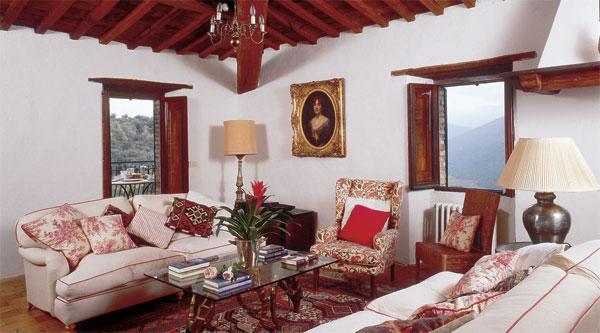She knew it was completely crazy, but Penny Radford had just fallen in love with a burned- out ruin perched on a hilltop overlooking the northern Umbrian hamlet of Santa Giuliana.The views were stupendous, the house a total wreck. To even consider restoration was completely unrealistic, an impossible challenge. She bought it of course.
Nine years on, the ruin is now a beautiful country house, a comfortable retreat for the world-weary and their families.
Before embarking on her project, Penny enrolled on a three-month language course at Perugia’s Università per Stranieri in order to help her deal with the arcane vagaries of Italian bureaucracy and, equally as important, to be able to explain to builders and tradesmen her precise requirements. As a result, everyday matters like attempting to buy screws from bemused ironmongers slowly became more manageable, and she no longer dissolved into tears whilst trying to describe requirements for a complex do-it-yourself job.
After a successful London-based career in marketing, Penny was embarking on something completely new, something which was going to test both her stamina and resolve. She readily admits that the first three years were clouded with feelings of disbelief at just what she had taken on. But as she puts it herself: ‘I had burned my bridges and now I just had to get on with it.’
The first practical step was to find a builder willing to undertake the mammoth restoration work. Initially she was met with scepticism. In this very traditional society, the idea of a builder taking instruction from a foreign woman living alone up a mountain in the middle of nowhere did not sit comfortably! However, with much persuasion the work eventually started. Slowly, as tradesmen realised that she knew what she wanted and was sympathetic to traditional methods of building, their enthusiasm grew. Her grand vision and attention to detail earned respect, and very quickly a creative working team was established. The first part of the original farmhouse began to take shape and Penny now had a roof, if not a terribly large one, over her head.
Rescue Work
A passionate gardener, Penny wanted to start work on her land immediately rather than wait until every last piece of restoration work had been completed on the farmhouse and outbuildings. But the garden was non-existent - it was just an overgrown hillside with some olive trees and several mountains of builder’s rubble. Most of the wildlife of Umbria had taken up residence in thickets of impenetrable brambles and nettles three feet high. Decades of peaceful co-existence between bats, lizards, snakes, wild hare and the occasional trundling cinghiale (wild boar) were about to be disturbed. A long, sweeping gravel drive was installed, complemented with two rows of tall, slender cypresses, leading to the main house. Some of the mature olives were successfully transplanted, lilac trees planted, pergolas built, terraces laid and Archibald the rooster, with his happy consort of hens, moved into the coop.
The 13th-century olive mill adjacent to the main farmhouse was next on the list. It was converted into a delightful apartment on two floors with its own elevated terrace sitting above an abundant fig tree which acts as a shady resting place for Penny’s guardians - the labradors. With their slowly wagging tails and quiet curiosity they are an integral part of Prato di Sotto and seem to think that the surrounding splendour has been created purely and simply for them. It would be nice if this were true, but they have to share the space with Penny’s human guests too. And not only humans, for Penny has a habit of collecting waifs and strays. The labradors happily share their domain with an assortment of abandoned hunting dogs and pregnant cats rescued from car parks.
Water, Water...
Two more buildings awaited the attention of the builder, but technical problems made progress difficult. The major problem was the lack of water, and it took a long time to resolve. After employing five water diviners, Penny summoned the sixth. He criss-crossed the property until the hazel twig twitched and he pronounced that this was the spot where water would be found. The drilling rig duly arrived and work began. The well was completed and there was indeed water, but no sooner did it appear than it seeped away. They discovered that the underlying stone was porous limestone and there was nothing that could be done. It was one step forward and two steps back. Another well was drilled, then a third with the same poor results. But Penny was determined to find a solution, and finally a combination of collecting all the rainwater from the roof and tapping into a nearby spring seemed to do the trick.
‘Water really is the biggest problem here,’ says Penny, although it’s hard to believe when looking at the lovely garden. Careful planning and shrewd observation of what grows well in the locality have been fundamental to its success. The prevailing colours are soft grey-greens, white and lilac. There are white climbing roses everywhere and an abundant wisteria cascades from the largest of the pergolas. Potted hydrangeas and geraniums add vibrant splashes of colour against the warm, mellow stone of the buildings. The silvery grey-green of a row of cipressa argentata picks up the colour of the blue-grey shutters, which keep the interior cool during the heat of summer days.
Natural Skill
The furnishings Penny has chosen for the house and apartments are a diverse and seemingly unusual combination, but they work extremely well together. Antique kilims, Sri Lankan colonial armchairs and 19th-century French mirrors live together in an easy harmony. There are imported French beams in the ceilings and the doors leading to the library are from a monastery. From the Sicilian baroque fireplaces to the reclaimed marble bathroom sinks, everything looks as though it has evolved naturally rather than from the skill of a born decorator. It takes confidence and talent to be able to blend such disparate elements into a convincing whole. Not surprisingly, Penny is now using those skills by helping new arrivals in the area to make the most of their own burned-out ruins. Her experience is a boon for those who, like her, have been seduced by the beauty of Umbria and want so much to lay claim to a part of it.
The visitors’ book at Prato di Sotto is filled with glowing accounts of all too brief stays. Guests return happily year after year, but what is it that brings them back? Is it the sublime views with the lights of Santa Giuliana twinkling below on a summer’s evening, or the nightingale’s song? Is it the aroma of wild thyme wafting on the breeze, or the sound of cuckoos calling to each other? Perhaps it’s the welcome you receive, or being brought bunches of fresh herbs from the garden together with those free-range eggs. Or maybe it is the spirit of the house which has emerged unscathed from the ashes, thanks to the woman whose heart was captured by a neglected ruin on a hill all those years ago.












